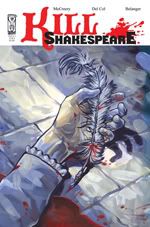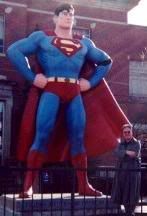| Pop Culture Gadabout | ||
|
Thursday, January 27, 2011 ( 1/27/2011 07:04:00 PM ) Bill S.  “THE QUALITY OF WILL’S MERCY IS NOT STRAINED.” A literate mash-up of graphic novel fantasizing with the works of the Bard of Avon, Kill Shakespeare (IDW) owes much to Fables and The League of Extraordinary Gentlemen. In all three works, familiar literary characters are flung together in a shared universe (Gentlemen, for instance, taking figures from Victorian entertainments and teaming them), though neither of the previous graphic series arguably has as high a literary pedigree as Will Shakespeare. That the source for this new series can frequently be viewed as daunting to many modern readers, though, should not deter them from checking out this appealing graphic fantasy series. “THE QUALITY OF WILL’S MERCY IS NOT STRAINED.” A literate mash-up of graphic novel fantasizing with the works of the Bard of Avon, Kill Shakespeare (IDW) owes much to Fables and The League of Extraordinary Gentlemen. In all three works, familiar literary characters are flung together in a shared universe (Gentlemen, for instance, taking figures from Victorian entertainments and teaming them), though neither of the previous graphic series arguably has as high a literary pedigree as Will Shakespeare. That the source for this new series can frequently be viewed as daunting to many modern readers, though, should not deter them from checking out this appealing graphic fantasy series.Conor McCreery and Anthony Del Col’s script opens on a moment in “Hamlet” that we typically never see: the period where the tragic hero has been banished to England (after erroneously killing the old man Polonius) with his friends Rosencrantz and Guildenstern in possession of a letter ordering Hamlet’s execution. Only in this version, Rosencrantz lets our hero know of the letter and our hero escapes into another realm where he’s “rescued” by the lead from one of Shakespeare’s historical plays, Richard III. To the deformed Richard, Hamlet is a prophesized figure, the Shadow King, who it is said will free them all “from the tyranny of William Shakespeare.” In a world where figures from comedies and tragedies intermingle, the playwright is viewed as a deity -- and his quill a talisman of unimaginable power. Hamlet, none too surprisingly, has his doubts, and the reader quickly realizes that for once he’s right. King Richard is in an unholy alliance with two other Globe-trotting dastards, snake-tongued Iago and Lady MacBeth, who are trying to manipulate the Dane into doing their wicked deeds for them. On the other side: comic figure Falstaff, Othello and a sword wielding Juliet Capulet. McCreery and Del Col pack their story with broad and sly allusions to Shakespearean theatre -- and their work remains true to the wide sweep of his plays. Readers who haven’t brushed up their Shakespeare recently may be surprised by the amount of bawdy and gory moments in this opening volume, though if you recall the on-stage blinding in King Lear or the even more horrendous scenes in Titus Andronicus what is shown by artist Andy Belanger here will still look rather tame. The bawdy stuff -- much of it connected to Falstaff -- is less explicit, though we do gets lots of deep cleavage and an amusing drag scene. Belanger’s art has a slightly comic tinge to it that suits the literary gameplaying going on here; on more than one occasion, I was reminded of the work Jack Davis used to do when he was illustrating war and horror comics for EC. (There’s a scene where Hamlet is haunted by ghosts in a swamp that could’ve come out of Tales from the Crypt.) His treatment of the vampish Lady MacBeth is especially inspired: every time I saw her in the book, I was reminded of Helen Mirren’s imposingly sexy turn as Morgan Le Fay in Excalibur, especially in a “Cask of Amontillado” inspired scene that occurs mid-volume. Kill Shakespeare may follow earlier comic book entertainments like Alan Moore’s tribute to the books he read as a lad, but it’s arguably closer to its source material. Part of the kick of a League of Extraordinary Gentlemen or a Fables, after all, resides in the way the series’ familiar players are re-imagined as more “grown-up” creations. In Shakespeare, each figure is true to their own self. Which is as we like it. (First published on Blogcritics.) Labels: modern comics # |Wednesday, January 26, 2011 ( 1/26/2011 06:46:00 AM ) Bill S. MIDWEEK MUSIC VIDEO: Thinking of bands I like and haven't played recently, I started jonesing for these grrls, so here's a clip from the Donnas: # | Monday, January 24, 2011 ( 1/24/2011 07:18:00 AM ) Bill S.  “SOMETIMES YOU HAVE TO BREAK THE LAW TO GET JUSTICE.” Taking a cast of fabled Wild West heroes and anti-heroes and depositing ‘em into a near future Nevada, Radical Comics’ five-ish “mature readers” mini-series Earp: Saints for Sinners is an agreeably foul-mouthed actioner set in an all-too-plausible Depression Era where Las Vegas is “the only boom town left” in America and the world has reverted to rough-hewn pistol-packin’ justice. “SOMETIMES YOU HAVE TO BREAK THE LAW TO GET JUSTICE.” Taking a cast of fabled Wild West heroes and anti-heroes and depositing ‘em into a near future Nevada, Radical Comics’ five-ish “mature readers” mini-series Earp: Saints for Sinners is an agreeably foul-mouthed actioner set in an all-too-plausible Depression Era where Las Vegas is “the only boom town left” in America and the world has reverted to rough-hewn pistol-packin’ justice.The comic follows former U.S. Marshall Wyatt Earp and his pal Doc Holiday as they come up against outlaws, thuggish Pinkerton agents (a.k.a. “Pinks”) and corrupt city politicians in this new/old frontier. Out title lead, Wyatt, has retired from law enforcement at the start of the story to run his own casino, the A-One Hotel and Saloon, when the reappearance of his headstrong brother Morgan Earp shoves him once more into the fray. Morgan has hooked up with celebrity bank robber Jesse James to get into the redistribution of wealth business -- none too surprisingly, a full-blown market crash has heightened the disparity between haves and have-nots even more distinctly -- and his presence in Las Vegas provides the Pinks an excuse to try strong-arming the ex-lawman. You just know this is gonna piss Wyatt off. Writers M. Zachary Sherman and Matt Cirulnick take the familiars of basic Western conflict and add enough doses of modern cop drama (courtesy a Doc Holiday flashback involving dirty fellow cops) plus dystopian s-f to keep things interesting. A trio of artists (Mack Chater, Martin Montiel, and Colin Lorimer) tackles the visuals, making boomtown Las Vegas look as grimly dark as the urban landscape in Blade Runner. If the first issue’s two big action scenes -- a flashback train robbery and an assault on Wyatt’s home -- come across more murkily chaotic than necessary, the aftermath of each is strong enough to keep us reading. Earp: Saints for Sinners may not break any new ground, but it mixes things up with heaps of storytelling enthusiasm. (First published on Blogcritics.) Labels: fifteen-minute comic # | |
|
|

